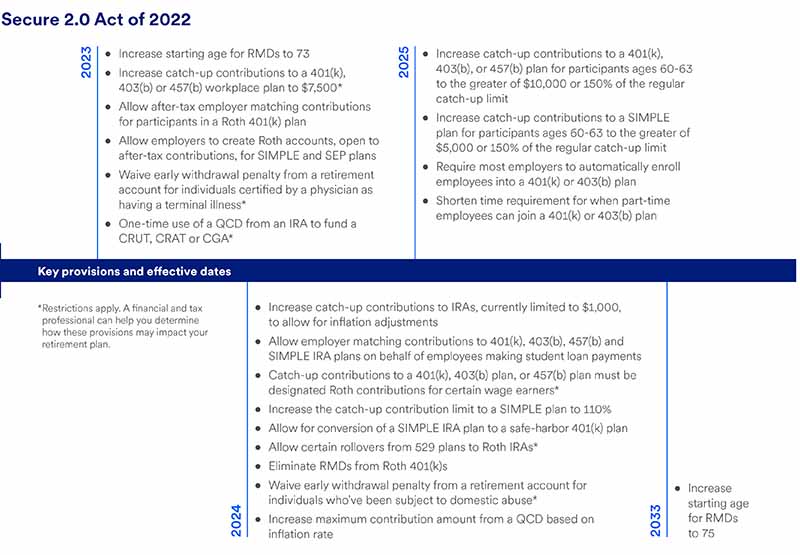SECURE 2.0 Act provisions in effect through 2024
The SECURE 2.0 Act raises the starting age for RMDs.
The threshold age that determines when you must begin taking required minimum distributions (RMDs) from traditional IRAs and employer sponsored retirement plans has increased from 72 to 73.
What this means is that you now can choose to delay taking your first RMD until April 1 of the year after the year in which you turn 73. From that point on, you must take your RMDs each year by December 31. In addition, the penalty for failing to take RMDs on a timely basis has been lowered from 50% to 25%.
It’s important to note that delaying RMDs means the amount of withdrawals required in later years may be larger, which could move you into a higher tax bracket. And since your RMD amount is calculated by dividing your account balance on December 31 of the prior year by your life expectancy, a year with strong market performance may also move you into a higher tax bracket.
You can minimize the tax impact of this provision in a couple of ways:
- Donating an RMD, in any amount up to $105,000 for 2024, from a traditional IRA directly to a qualified charitable organization. This is known as a qualified charitable distribution (QCD) and it’s available to individuals 70 ½ years of age or older. QCDs are often an overlooked planning opportunity for individuals to manage gifts and reduce taxes.
- Building a tax-diversified portfolio that includes taxable (traditional brokerage accounts) and tax-free (Roth) accounts, which are exempt from RMDs.
The SECURE 2.0 Act increases employer-sponsored retirement plan catch-up contributions.
Catch-up contributions allow people age 50 and older to set aside additional dollars beyond the standard maximum contributions to employer-sponsored retirement plans.
Effective in 2023 and 2024, the maximum additional catch-up contribution to an employer plan increased from $6,500 to $7,500 per year and remains at $7,500 for 2025 for those 50-59.
The SECURE 2.0 Act makes changes to employer-sponsored Roth 401(k) plans.
If you have a Roth 401(k) plan through your employer, and if the employer plan is updated to allow it, you can choose to have your employer’s matching contributions directed to your Roth 401(k) account. These contributions are considered taxable income in the year of the contribution, but future growth or withdrawals are tax free.
In addition, employers can now elect to add after-tax Roth contributions to accounts for SIMPLE IRA and SEP IRA retirement plans. Like Roth IRAs, starting in 2024, Roth 401(k)s are no longer subject to RMDs.
The SECURE 2.0 Act allows more penalty-free early withdrawals.
There’s generally a 10% tax penalty if you take distributions from a retirement account before you turn 59 ½. The SECURE 2.0 Act expands the circumstances where penalty-free “hardship” withdrawals could occur if the employer elects to provide them in the plan. The 10% penalty will be waived for:
- Individuals certified by a physician as having a terminal illness or condition that can reasonably result in death in 84 months or less (withdrawals of any amount).
- Individuals in federally declared natural disaster areas (withdrawals up to $22,000).
- Domestic abuse victims within the past 12 months (withdrawals up to the lesser of $10,000 or 50% of the vested balance of the account). All or a portion must be repaid within three years.
- Individuals facing financial emergencies (one withdrawal per year up to $1,000 is allowed). Certain criteria must be met before they can make subsequent withdrawals.
The SECURE 2.0 Act introduces new rules for QCDs.
As stated previously, individuals who are 70 1/2 and older can direct over $100,000 in distributions per year from a traditional IRA to a QCD. The contribution limit is indexed for inflation annually.
You also have a one-time opportunity to also use a QCD of up to $50,000 from an IRA to fund a charitable remainder unitrust (CRUT), charitable remainder annuity trust (CRAT) or a charitable gift annuity (CGA). As in a regular QCD distribution, there is no tax deduction for making this gift; however, the distribution will count against the RMD for that year.
The SECURE 2.0 Act brings in new limits for qualified longevity annuity contracts (QLACs).
The maximum amount that you can use to purchase QLACs is now $200,000 (up from $145,000). In addition, the “25% of account balance” limitation is eliminated.
The SECURE 2.0 Act allows employers to make retirement plan contributions for employees with student loan debts.
Employers can elect to make contributions to retirement plans on behalf of employees who are still repaying student loans, even if those employees do not make retirement plan contributions themselves. Employer contributions can match the amounts of student loan debt repaid by the employee in a given year.
This provision creates an excellent opportunity for employers to offer an incentive to attract and retain employees. It could prove to be an effective way to kick-start a retirement savings plan for younger workers who are burdened with student loans.
The SECURE 2.0 Act allows rollovers of 529 plan balances to Roth IRAs.
You can now roll up to $35,000 of leftover funds in a 529 education savings plan into a Roth IRA over the course of several years due to the annual contribution limit to a Roth IRA. Balances above $35,000 can be taken as a non-qualified distribution, but the earnings portion of the distribution is subject to income tax and a 10% penalty.
This provision reduces the fear of overfunding a 529 plan by allowing excess funds to be used for other needs without penalty. The $35,000 threshold is a lifetime limit subject to a few restrictions:
- The 529 account must have been in place for at least 15 years.
- Funds in an amount up to the maximum annual Roth IRA contribution limit must be transferred directly into a Roth IRA for the same individual who was the beneficiary of the 529 plan.
- Any 529 plan contributions made in the previous five years, and any earnings attributed to those contributions, are not eligible to be rolled into a Roth IRA.
- The amount transferred into a Roth IRA each year must be within annual Roth IRA contribution limits.
The SECURE 2.0 Act updates rules for withdrawals from inherited IRAs and 401(k)s.
The 2019 SECURE Act mandated the full withdrawal of inherited IRAs and 401(k)s within 10 years of the account holder’s death for most non-spouse beneficiaries. Before this, non-spouse beneficiaries could generally stretch withdrawals over their lifetime according to IRS life expectancy tables.
An ambiguity in the law led many to believe that non-spouse beneficiaries only had to withdraw the entire account balance by the 10th year. But in 2022, the IRS issued proposed regulations requiring that RMDs be taken each year during the 10-year period. Final regulations issued in 2024 confirm this, which means non-spouse beneficiaries cannot wait until the 10th year to withdraw the full account balance.
Due to the ambiguity of the law, the IRS will not assess penalties on non-spouse beneficiaries who did not take RMDs between 2021 and 2024, or require them to make up these missed RMDs.



